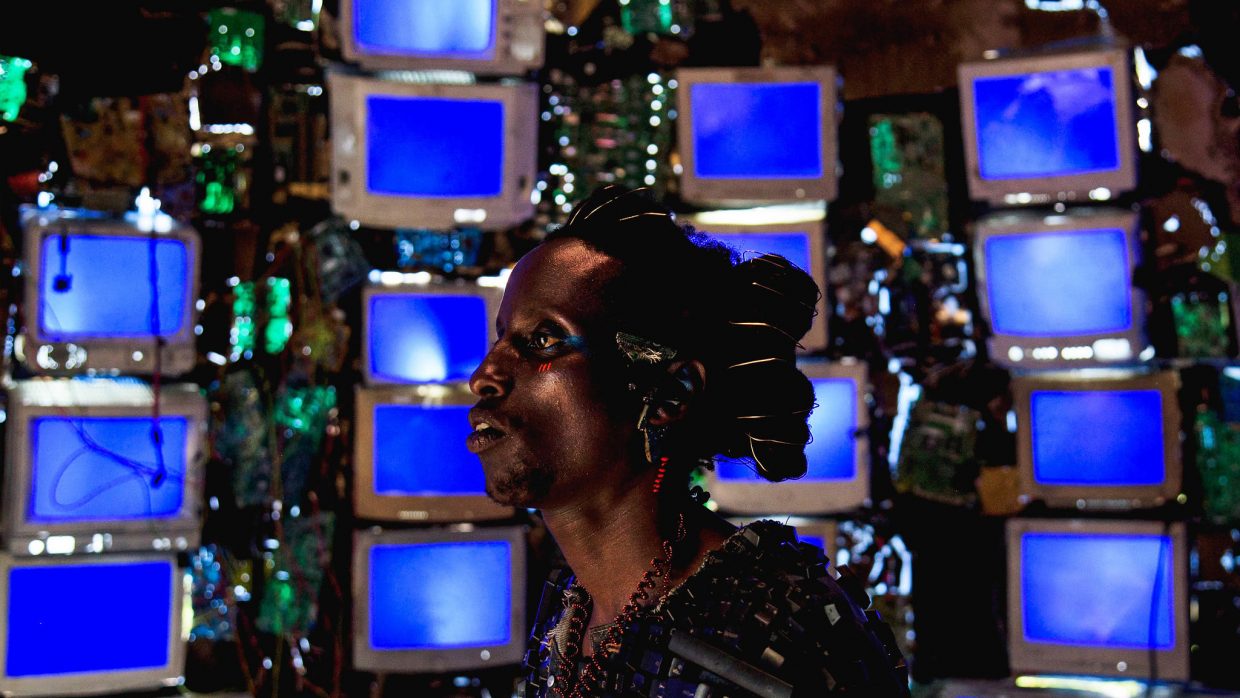 Back to selection
Back to selection
“The Camera Movements Were Almost Choreographed to Amplify the Ensemble Feeling, the Dances and the Musicality of That Universe”: DP Anisia Uzeyman on Neptune Frost
 Cheryl Isheja in Neptune Frost by Anisia Uzeyman and Saul Williams.
Cheryl Isheja in Neptune Frost by Anisia Uzeyman and Saul Williams. Neptune Frost is an Afrofuturist musical that tells the story of a group of African miners digging for the material that sustains a digital network, as well as an emergent connection between a miner and an intersex runaway. Co-director and cinematographer Anisia Uzeyman discusses how she captured the film’s distinctive and colorful aesthetic.
Filmmaker: How and why did you wind up being the cinematographer of your film? What were the factors and attributes that led to your being hired for this job?
Uzeyman: Saul and I worked side by side on the creation of this project from the beginning. We developed the cinematic language together and he insisted that I would be the DP of Neptune Frost, so I went into deep and long studies and camera tests for two years. I think the freshness of my take and the freedom that goes with it were the key factors. He knew I would dare to push for the so-called impossible. Also, my connection to Rwanda, to music and my feminine gaze are part of the reason it was me.
Filmmaker: What were your artistic goals on this film, and how did you realize them? How did you want your cinematography to enhance the film’s storytelling and treatment of its characters?
Uzeyman: I wanted the cinematography to be epic, slightly bigger than reality and at the same time very emotional.
To secure the high quality I was envisioning for the specificity of a sci-fi musical, while also—because we shot the film in Rwanda—relying on constant inventiveness, I have to thank my amazing team of technicians.
We created a color palette for the outside world as well as for Digitaria to give an otherworldly feeling to that universe. All the choices were made to touch on the emotional journey of the characters as they go through a transformative time. The camera movements were almost choreographed to amplify the ensemble feeling, the dances and the musicality of that universe.
Filmmaker: Were there any specific influences on your cinematography, whether they be other films, or visual art, of photography, or something else?
Uzeyman: There are many influences. I was inspired by some of the work of the new wave of African photographers like Daniel Obasi, David Uzochukwu, Atong Atem, Zanele Muholi, and Travis Owen. Sun Ra’s film Space Is The Place. Andrei Tarkovsky’s writings and films, especially Solaris, certainly played a huge part in my understanding of camera movements. The emotional lighting and resourceful filming of DP Christopher Doyle for Wong Kar-wai and more specifically his sci-fi 2046. Djibril Diop Mambety’s Hyenas. John Cassavetes. The paintings of Barkley Hendricks. The installations of Jasmine Murrell. The Wiz’s ensemble scenes. Some hip-hop music videos from the ’90s… These are only a few.
Filmmaker: What were the biggest challenges posed by production to those goals?
Uzeyman: The lack of cinema gear and rental equipment in Rwanda was a huge practical challenge for a 27 day shoot across the country. We had to work with local resources to literally build our own tracks, rails, dolly, LED panels and apple boxes, and held lighting auditions at our production office with lights gathered from night clubs, churches and concert venues. That was a lot of fun. Lighting continuity was the most challenging.
Filmmaker: What camera did you shoot on? Why did you choose the camera that you did? What lenses did you use?
Uzeyman: We had the privilege to have ARRI lend us the Alexa Mini and an Alura Fujinon Zoom. We added a set of Lomo Illumina S35mm.
Filmmaker: Describe your approach to lighting.
Uzeyman: I was really focused on enhancing the actors’ emotions and the landscape’s inherent power for the natural resources to be alive. We wanted a texture that organically evolved into the futuristic and otherworldly tech atmosphere of the film. We mostly used low key lighting, colorful bounces, reflectors, diffuser grid and a great deal of gels, in addition to a few camera filters to create moody contrasts and brilliance with a mythical feel.
Filmmaker: What was the most difficult scene to realize and why? And how did you do it?
Uzeyman: Because of the scale of the production with a huge cast and music playback, movement and choreography, there was no easy scene to film really. But the night we shot the dream in an open stone quarry after a full day in a sorghum field is a long night to remember. We started by painting all the rocks while building the equivalent of a 25 meter rollercoaster traveling on rocks, the electricians pulled 500 meters of electric cable to be able to install the black lights, but when, at 2 A.M., we were finally ready to shoot the electricity went out! Anyway, we shot until sunrise.
Filmmaker: Finally, describe the finishing of the film. How much of your look was “baked in” versus realized in the DI?
Uzeyman: We discussed the main looks and the color palette with our colorist, who made a few LUTs before going into principal photography so we knew where we were heading. Some things were baked in, but for the majority of the film we found the balance in the DI.
TECH BOX
Film Title: Neptune Frost
Camera: ARRI Alexa Mini
Lenses: Lomo Illumina S35mm 18,25,50,65,85mm + ARRI Alura Fujinon Zoom 30-80mm
Lighting: 75% LEDs, 10% Tungsten, 10% Neon, 5% black lights, fluorescent lights, kerosene lamps
Processing: DaVinci Resolve
Color Grading: DaVinci Resolve
